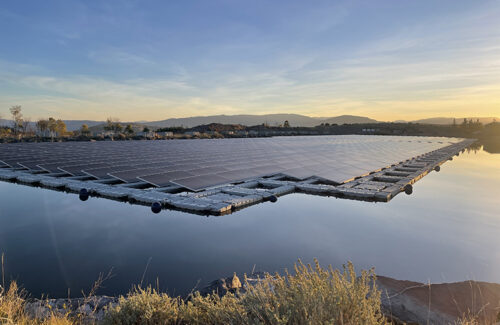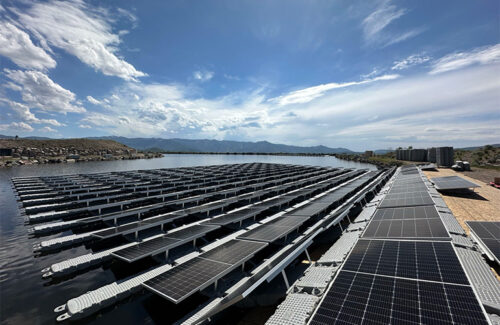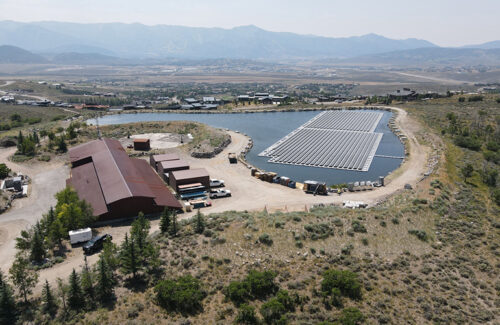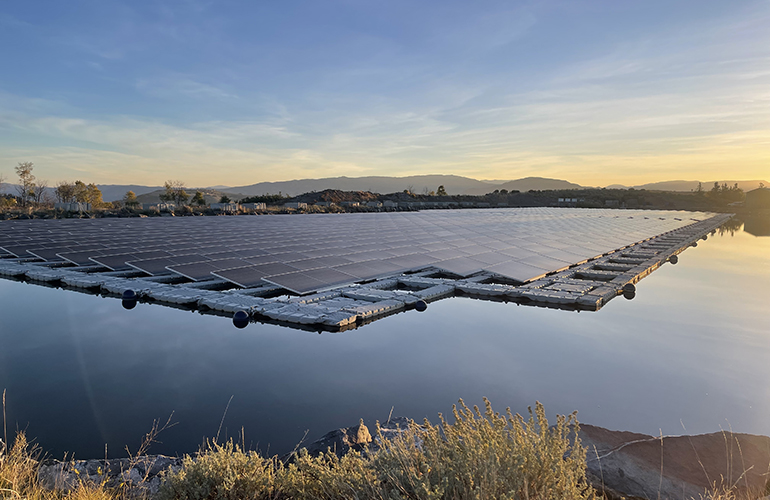The first floating solar project built in Utah is located on a reservoir atop a mountain at an elevation of 7,000 ft. This 587.5-kW solar project is powering a water treatment facility serving Park City, a skiing destination that draws millions of visitors annually.

D3Energy and Ameresco built Utah’s first floating solar project on a retention pond atop a mountain. D3Energy
Floating solar was Mountain Regional Water Special Service District’s (MRW) first choice for meeting its renewable energy goals. Land is valuable in Park City, both in cost and its contribution to the natural beauty of the place. Floating solar was the solution that covered the water utility’s energy consumption goals without using any land for construction.
MRW was inspired to put PV on the holding pond at the Signal Hill water treatment plant by a floating solar project GRID Alternatives built in Walden, Colorado, in 2018. That array is in a similar climate and proved to the utility that floating solar could handle the increased snow and wind conditions present at that elevation.
“The geographic location of this lake is pretty unique. You think of lakes being in a lower elevation, or in a basin or valley, where this lake is actually at the top of this community,” said David Goldenberg, project development engineer for Ameresco. “It gets really windswept, and it’s kind of nestled in there. They don’t expect snow to really stay accumulated at this location due to the winds and the amount of sun it gets.”
Floating at 7,000 ft
MRW issued a request for proposals for a floating solar project in June 2022, eventually hiring clean energy project developer Ameresco. During development, the company brought on floating solar contractor D3Energy, with whom Ameresco had previously collaborated on a project at Fort Liberty Army base in North Carolina.
Despite this being the first floating solar array in Utah, Daniel Hunter, senior business development manager at Ameresco, said that the project was surprisingly well-received. Permitting went smoothly and there was minimal pushback from the community — even with oversight from a surrounding neighborhood’s homeowners’ association.
Component procurement began in January 2024, and construction started in June. The array is composed of 1,078 JA Solar 545-W modules, three Yaskawa Solectria XGI 1500-175-480-kW inverters and a Ciel & Terre Hydrelio floating racking system.
Ameresco and D3Energy hired local solar contractor Apollo Energy to help with construction, which meant training these contractors in floating solar. System assembly occurred mostly onshore. The floating racking, modules and wiring were connected in sections on the lake’s bank.

The Signal Hill floating solar project was assembled in sections onshore and pushed out into the water to be assembled. D3Energy
“This one was a little challenging because of the contour of the lake itself,” said Stetson Tchividjian, managing director of D3Energy. “Usually, we like to have a long edge that we can build the whole thing in just a couple pieces. We would have built it probably in one, maybe two pieces. Because we had such limited straight line shore space, we had to build this in like five or six pieces.”
Those assembled sections were then pushed onto the pond, floated into place and connected to one another and to the mooring lines that lead to ballasted anchors placed onshore.
Connecting to onshore ballast anchors is unusual for floating solar. There are several options for anchoring floating projects in place, including weighted ballasts and penetrating piles, and mooring lines can be tied to those foundations onshore or on a lakebed. Contractors couldn’t penetrate or use ballasts on the bed of the water treatment holding pond, which is covered in an artificial liner.
Developers conducted a bathymetric survey of the pond to determine its depth, because the array had to compensate for varying water levels. The pond is fully drained once every few years, and the array must move with rising and falling waters with gradual depth changes of around 10 ft.
“The way that we had to design our anchoring system was you essentially had to have enough slack in those lines to where, when they do drain it, it can go all the way down,” Tchividjian said.
Additionally, the project’s inverters and power electronics are located on land. The floating array at Signal Hill started operations in September 2024.
Implications of a novel floating solar project
Floating solar construction has its advantages when it comes to land use. For one, it doesn’t take up any land to build a floating project. Floating arrays use buoyant racking assemblies with comparably smaller profiles than traditional ground-mounted systems, meaning the projects occupy smaller footprints and have no inter-row shading.
The array at Signal Hill occupies an acre of water. Tchividjian said a similarly sized project on land would take up two to three acres. There’s no need for a fence when there’s the built-in security of being out on water; and covering water prevents evaporation loss and keeps modules cooler and cleaner.
“When you think about it, you have this nice flat surface already,” Goldenberg said. “You don’t have to do all this civil work. Like on a ground-mount, we would have to move a lot of dirt around to flatten it.”
Although the Signal Hill array was completed on a relatively short timeline and slotted well into its place in Park City, its fate wasn’t always clear.

The Signal Hill floating solar project in Park City, Utah. D3Energy
“We were laughing about this at the ribbon cutting, because there was about three different times that we thought this project was dead in the water, for a variety of reasons, mostly economic,” Tchividjian said.
A $400,000 grant from Rocky Mountain Power’s Blue Sky Award Program was a significant boon to the Signal Hill floating solar project. That funding made it possible to arrange a 10-year payback period for MRW instead of using a power purchase or lease agreement with a longer financial commitment.
D3Energy and Ameresco will maintain the floating project for the long-term. D3 is handling upkeep of specialized floating solar equipment, and Ameresco will monitor the system.
“O&M is an interesting aspect for floating solar, and the more we build these systems, the more we started to see that it’s actually a big pro for floating solar vs. ground systems,” Tchividjian said. “The reason I say that is the system itself doesn’t need a lot of love and care. All of the O&M costs that you think of with a ground system essentially gets zeroed out. Mowing the lawn, fencing, vegetation control, security — all of those go to zero with floating solar, with it being out on water.”
Having power electronics onshore means project operators might not have to traverse the pond for maintenance, a safer prospect for technicians, especially during the winter months.
The Signal Hill solar array is freshly operating and facing its first winter. Without the inspiration from a similar project in Colorado, the first floating solar array in Utah might not exist. In the present, it will help a regional water treatment plant meet its clean energy goals, but its legacy is yet to be determined.
“Typically, people don’t look at your pond and think, ‘This is a great solar opportunity.’ But hopefully this project gives people that idea,” Ameresco’s Hunter said. “Usually for us, we’re looking at rooftop, covered parking or a large ground mount. To be able to throw ponds in as another available area for solar, especially with large wastewater treatment plants, that’s a wildly huge benefit that we definitely want to see other people take advantage of into the future.”

